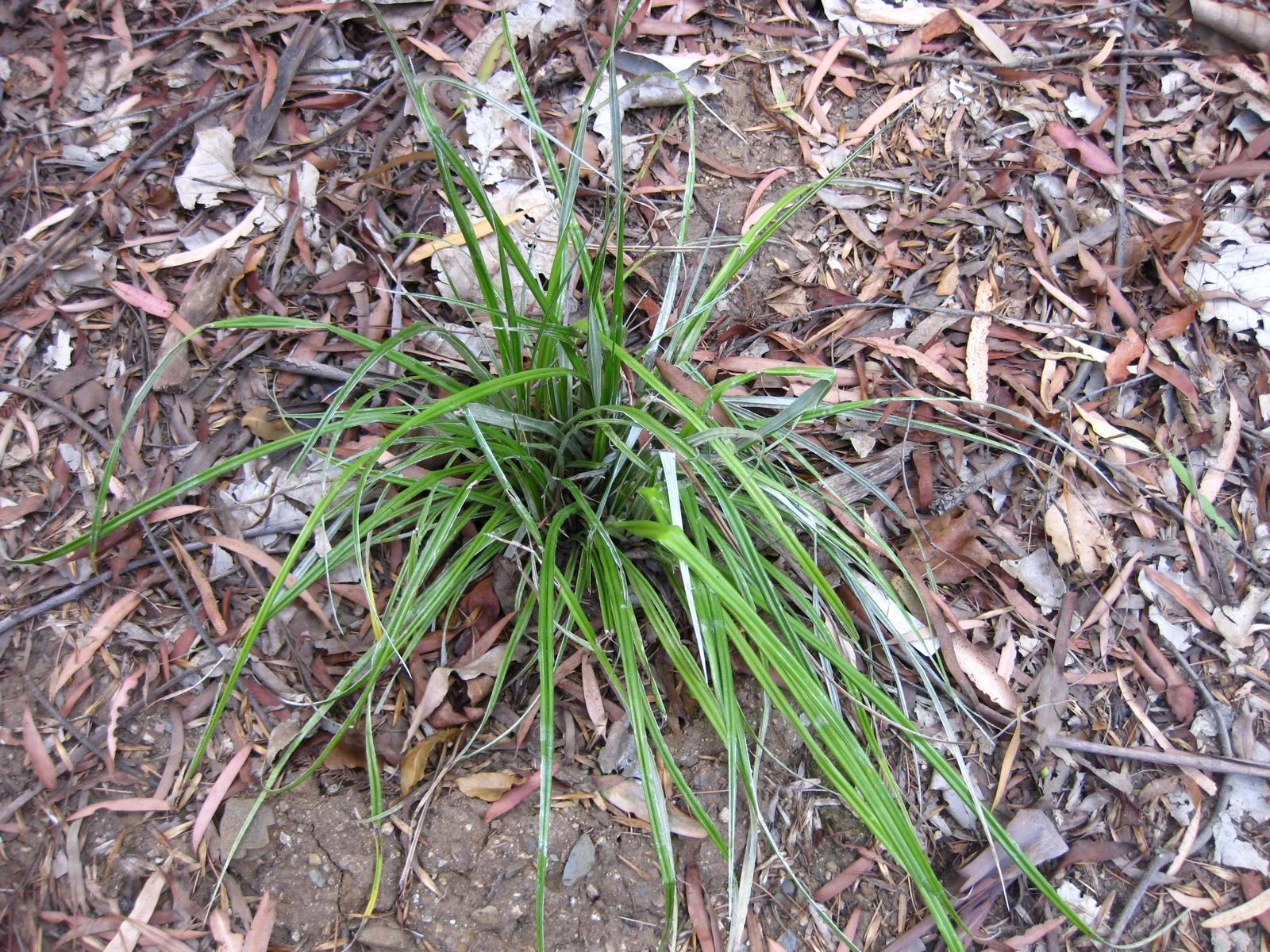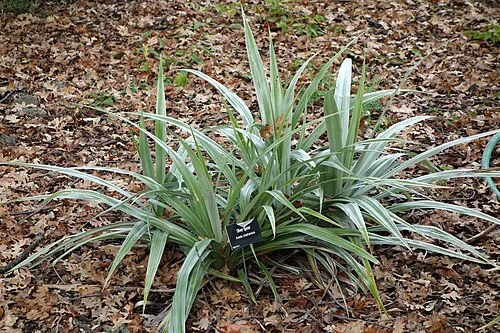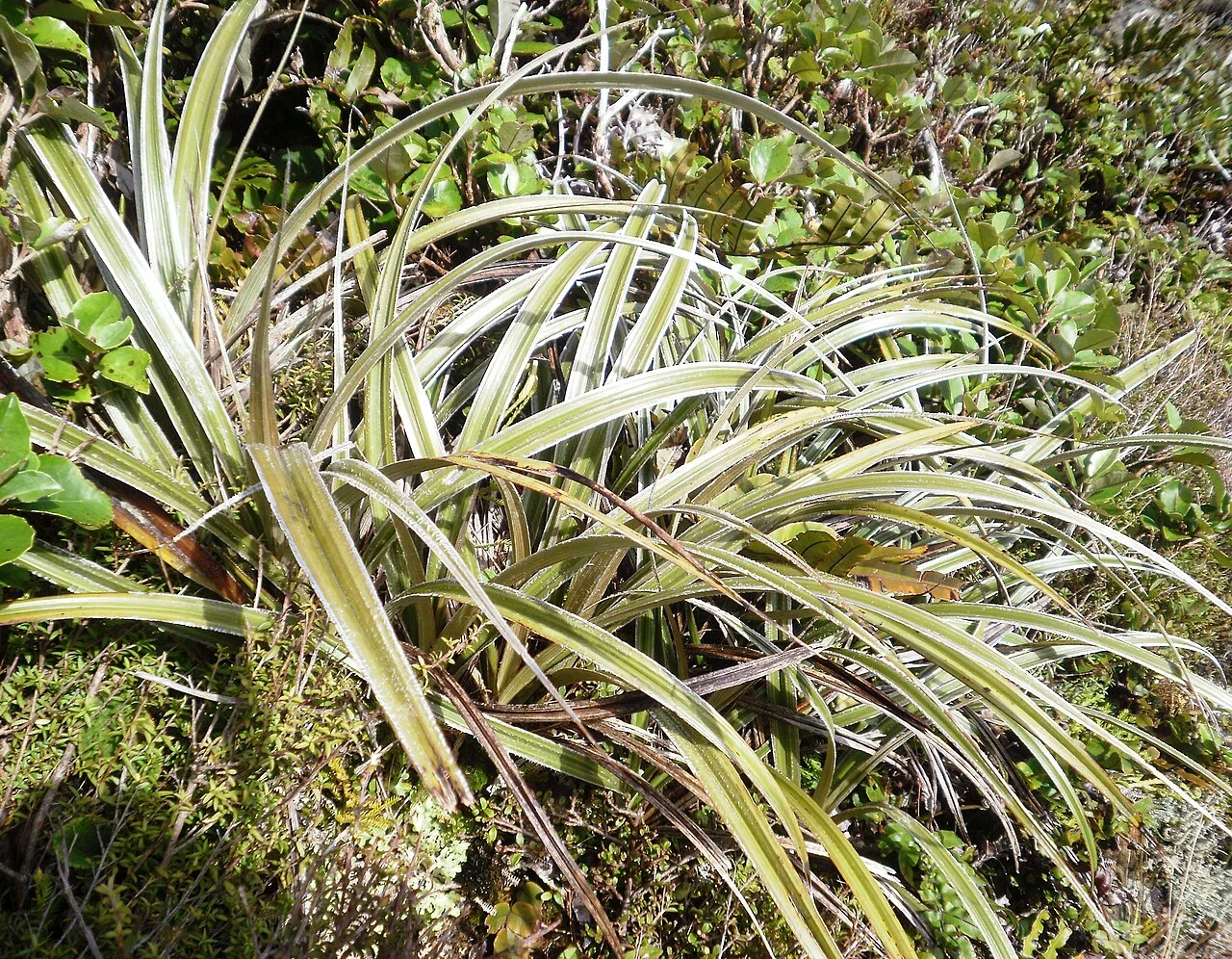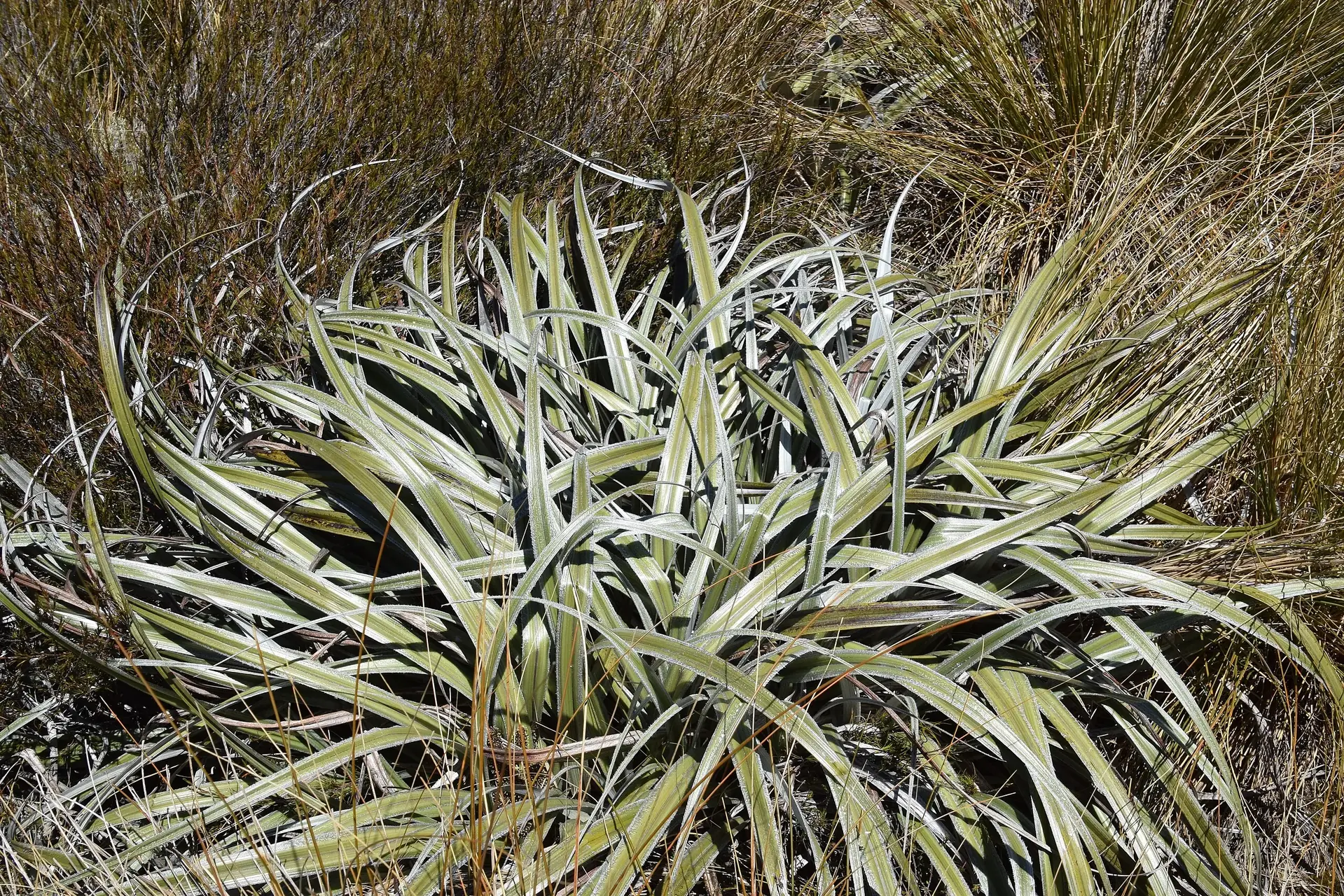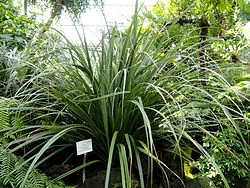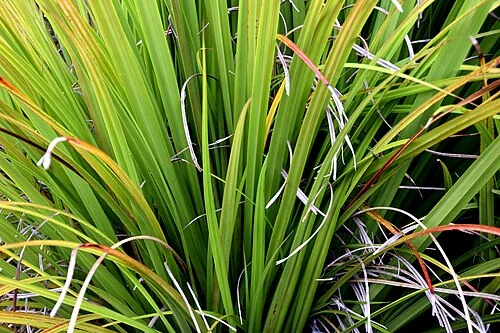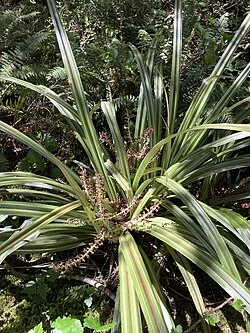
Bush Lily
Astelia fragrans
Bush Lily ( Astelia fragrans ) is a remarkable native New Zealand herbaceous perennial that represents one of the country's most distinctive endemic species. Known to Māori as "kākaha," this impressive wetland plant is the most common Astelia species found throughout New Zealand's diverse ecosystems. The plant forms striking clumps of long, sword-like green leaves that can grow up to 1.5 meters in length, often featuring distinctive red midribs and sometimes displaying silvery undersides that catch the light beautifully. From October to November, Bush Lily produces clusters of small, sweetly scented green flowers, followed by attractive yellow-orange berries during summer months that provide valuable food for native birds and lizards. This adaptable species thrives from sea level to approximately 900 meters elevation, making it an excellent choice for traditional gardens and modern landscape designs seeking authentic New Zealand flora. First scientifically described by renowned botanist William Colenso in 1883, Bush Lily continues to play a vital ecological role in New Zealand's native ecosystems while offering gardeners a low-maintenance, architecturally striking plant with significant cultural heritage.

Plant Description
Astelia fragrans (kākaha, bush flax) forms clumps of arching, sword-like leaves with silvery undersides. Fragrant, drooping panicles are followed by orange berries eaten by birds.
Quick Facts
Key Characteristics
| Scientific Name | Astelia Fragrans |
|---|---|
| Common Name | Bush Lily, Bush Flax, Kakaha |
| Plant Type | Herbaceous perennial, evergreen clump-former |
| Height | 1-1.5 m (leaves can reach 1.5 m long) |
| Spread | 1-1.5 m wide clumps |
| Foliage | Long, sword-like green leaves with red midribs, sometimes silvery undersides |
| Flowers | Small green flowers in clusters (October-November) |
| Fruit | Yellow-orange berries (summer), attract native wildlife |
| Habitat | Wetlands, forest floors, stream margins, sea level to 900 m elevation |
| Family | Asteliaceae |
| Water Needs | Moderate to high - prefers moist but well-drained conditions |
| Light | Partial shade to full sun |
| Frost Tolerance | Hardy - tolerates moderate frosts |
| Salt Tolerance | Low - not suitable for coastal salt exposure |
| Growth Rate | Moderate - establishes well once planted |
| Lifespan | Long-lived perennial (decades with proper care) |
| Conservation Status | Not Threatened (stable endemic species) |
| Wildlife Value | Berries provide food for native birds and lizards |
Climate Best Suited to
Mild temperate climates with reliable moisture; tolerates light frost and coastal wind. Provide afternoon shade in hotter districts.
Regional Suitability
| City | Climate Suitability |
|---|---|
| Whangārei | Ideal |
| Auckland | Ideal |
| Hamilton | Ideal |
| Tauranga | Ideal |
| Rotorua | Ideal |
| Gisborne | Ideal |
| New Plymouth | Ideal |
| Napier | Ideal |
| Whanganui | Ideal |
| Palmerston North | Ideal |
| Wellington | Ideal |
| Nelson | Ideal |
| Christchurch | Ideal |
| Dunedin | Ideal |
| Invercargill | Ideal |
Natural Habitat
Kākaha ( Astelia fragrans ) grows from coastal lowland to montane forest, favouring humid gullies, stream margins, and the sheltered edges of broadleaf-podocarp forest. It forms broad, arching fans on the ground or as a perch epiphyte on stable trunks where leaf litter accumulates. Consistent moisture, dappled light, and deep, humus-rich soils mirror its typical niche beneath tall canopy where wind is filtered and frost is moderated.
Conservation Status
Current Threats and Protection
Bush Lily ( Astelia fragrans ) maintains a secure conservation status of "Not Threatened" under New Zealand's threat classification system. This stable status has been consistently maintained through multiple assessments including 2023, 2017, 2012, 2009, and 2004 evaluations, reflecting the species' healthy population numbers and widespread natural distribution across New Zealand.
As an endemic New Zealand species, Bush Lily represents an important component of the country's unique botanical heritage. The species' classification as "Facultative Upland" (FACU) indicates its versatility, occasionally functioning as a hydrophyte in wetland environments but usually occurring in upland non-wetland habitats, demonstrating remarkable ecological adaptability.
While regionally stable with "Not Threatened" status in Otago, the species shows some regional variation with "Data Deficient" classification in Auckland, highlighting the importance of continued monitoring and habitat preservation. Bush Lily's widespread cultivation in native gardens and restoration projects contributes positively to conservation efforts, helping maintain genetic diversity and ecological connections across fragmented landscapes.
How to Grow Bush Lily
Bush Lily offers gardeners an exceptional opportunity to cultivate one of New Zealand's most distinctive native species, combining architectural beauty with ecological value and cultural significance. This robust perennial adapts well to cultivation and provides long-term garden interest with minimal maintenance once established.
Site Selection and Soil Requirements
Choose a location that receives partial shade to full sun, with Bush Lily performing best in areas that receive morning sun and afternoon shade. The plant thrives in fertile, well-drained soils that retain moisture but don't become waterlogged. Heavy clay soils should be improved with organic matter and coarse sand to enhance drainage, while sandy soils benefit from compost addition to improve water retention and nutrition.
Aftercare and Establishment
Plant Bush Lily in autumn or early spring when temperatures are moderate and rainfall is typically more reliable. Dig planting holes twice the width of the root system and incorporate well-rotted compost or aged manure to improve soil structure. Space plants 1.5-2 meters apart to allow for mature clump size, and water thoroughly after planting to eliminate air pockets around roots.
Seed Propagation
Fresh seed collected from ripe berries in summer provides the best germination success for Bush Lily. Clean seeds thoroughly and sow immediately in well-draining seed-raising mix, barely covering with fine potting medium. Maintain consistent moisture and provide bright, indirect light with temperatures between 18-22°C. Germination typically occurs within 4-8 weeks, though some seeds may take several months to establish.
Ongoing Care and Maintenance
Once established, Bush Lily requires minimal maintenance beyond regular watering during dry periods and annual application of balanced fertilizer in early spring. Remove spent flower heads to prevent excessive self-seeding if desired, though many gardeners appreciate the natural succession of volunteer seedlings. Mulch around plants with organic matter to conserve moisture and suppress weeds, keeping mulch away from the crown to prevent rot. The plant's natural form rarely requires pruning, though damaged or dead leaves can be removed at ground level as needed.
Planting Guide
Best Planting Practices
Space 1-1.2 m apart; set crowns level with soil and mulch to conserve moisture, keeping mulch clear of the central fan to prevent rot.
Ecology
Fruit feeds native birds; dense foliage shelters invertebrates and lizards; leaves contribute to forest litter cycling.
Flower spikes attract native pollinators, and persistent leaf litter builds humus on forest floors, improving water retention and soil structure in restoration sites.
Uses
Bold structural native for damp borders, mass planting and understory design.
Ideal for swales and rain-garden edges where intermittent saturation alternates with drainage; the evergreen fans deliver strong winter structure.
Landscaping Ideas
Combine with Carex , Chionochloa and glossy Griselinia for layered textures.
Repeat clumps to lead the eye along paths and stream margins, and underplant with shade-tolerant groundcovers to knit soil and suppress weeds.
Seasonal Care
Checklist
Spring: feed with general fertilizer. Summer: water during drought to prevent leaf tip browning. Autumn: tidy up dead basal leaves. Winter: protect young plants from severe frost.
Pruning
Pruning Techniques
Remove spent or tattered leaves at the base; avoid damage to the crown.
Divide over-large clumps in early spring to refresh vigour, resetting crowns at original height. Keep the central fan clear of mulch to prevent rot after heavy rain.
How to Grow Bush Lily ( Astelia fragrans )
Spores
Fresh seed collected from ripe berries in summer provides the best germination success for Bush Lily. Clean seeds thoroughly and sow immediately in well-draining seed-raising mix, barely covering with fine potting medium. Maintain consistent moisture and provide bright light at temperatures around 18-22°C. Germination typically occurs within 4-8 weeks, though some seeds may take several months to establish.
Division of Clumps
Established clumps can be divided in autumn (after flowering) or early spring (before new growth begins), when soil moisture is reliable. Carefully lift the entire plant and gently separate the clump into sections, ensuring each division has several healthy growing points and a good root system. Replant divisions at the same depth as the original plant. Water thoroughly after replanting to settle the soil and keep evenly moist until the divisions are re-established.
Planting and Establishment
Plant in full sun with well-drained, sandy soil; avoid waterlogged sites. Space plants to allow for natural spread and good airflow. Water regularly through the first growing season to encourage a strong root system, then reduce frequency as the plant becomes drought-tolerant. Apply a light, balanced slow-release fertilizer in spring if growth appears weak, but avoid over-fertilizing. Annually, trim old or spent foliage to refresh the clump and maintain a tidy habit.
Pests and Diseases
Common Problems and Solutions
Generally healthy; crown rot from poor drainage is the main issue. Occasional scale/mealybug in dry, stagnant air-treat with horticultural oil.
Leaf tip scorch signals drought or too much sun; shift to brighter shade and increase watering during dry spells. Remove old litter from the crown annually to reduce fungal issues in wet winters.
Cultural Significance
Traditional Uses and Values
Known to Māori as "kākaha" or "k wharawhara," Bush Lily holds deep cultural significance as part of New Zealand's indigenous plant heritage and traditional ecological knowledge. The species represents an important connection between contemporary conservation practices and ancestral understanding of native ecosystems, serving as both a practical and spiritual link to traditional Māori plant use.
Bush Lily's architectural form and distinctive appearance have made it a symbol of New Zealand's unique botanical character, often featured in cultural displays and native plant gardens that celebrate the country's endemic flora. The plant's role in traditional ecological systems, where its berries provided sustenance for native birds and its robust leaves offered materials for various uses, demonstrates the interconnected relationships that Māori traditionally recognized and maintained with native species.
Today, Bush Lily serves as an important ambassador species for New Zealand's native plant conservation efforts, helping to educate both locals and visitors about the country's remarkable endemic flora. Its widespread use in restoration projects, educational gardens, and landscape designs helps preserve not only the species itself but also the cultural knowledge and practices associated with native plant stewardship, ensuring this taonga (treasure) remains part of New Zealand's living heritage for future generations.
Bonus Tip
Expert Growing Advice
Set crowns slightly proud of the soil and keep mulch pulled back from the fan to prevent rot. In dry spells, a deep soak every 10-14 days is more effective than frequent light watering and preserves the plant's clean, architectural form.
